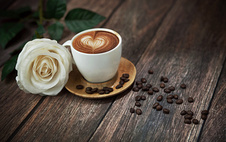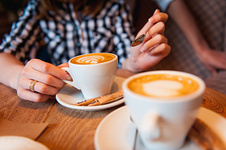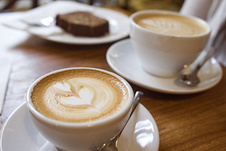French coffee shop culture, French coffee culture knowledge
Follow the caf é (Wechat official account vdailycom) and found that Beautiful Cafe opened a small shop of its own.
Coffee shop culture can be traced back to the last century, this nation has just moved from the feudal imperial court culture to cosmopolitan Shanghai, where the nutrition learned from cafes began to become popular. At that time, writers such as Shi Zhecun, Mu Shiying and Liu Naou often lingered in cafes, savoring one classic article after another in the warm, soft, sweet and astringent aroma of coffee. As a carrier of urban culture and an indispensable cell, cafes are duty-bound to undertake a major task of promoting cosmopolitanism.
When the "Gulf War" broke out in 1991, France was also one of the countries participating in the war. some domestic people worried that the war would affect the supply of daily necessities, so they rushed to supermarkets to buy them. Even the TV station was alarmed by the fact that when the camera looked at customers full of "scarce goods", they found that what they got the most was coffee and sugar. At one point, it became a big joke at that time.

The French do not seem to pay attention to the taste, but the environment and atmosphere. Most of them do not want to drink alone behind closed doors, but join in the fun outside, even if the price of a small cup is enough to make a pot at home. They did not drink hurriedly, but tasted it slowly, tasted it carefully, read books and newspapers, talked about it, and "soaked" for most of the day. When I walked through six or seven large exhibition halls at the Science and Technology Expo, I saw that there were cafes on the corner to facilitate exchanges and negotiations among people from all walks of life.
French people develop this habit of drinking coffee, whether they consciously express a kind of elegant charm, a kind of romantic sentiment, a kind of comfortable feeling of enjoying life. It can be said that this is a traditional and unique coffee culture. Because of this, the places where people can rest and drink coffee in France can be said to be all over the streets, under the shade of trees, by the road, by the square, on the river bank, on cruise ships, on street balconies, and even on the Eiffel Tower. There are coffee shops, cafes, halls, rooms, all of which are attached to buildings and covered by roofs, regardless of form, style, size or size. And the most popular and romantic ones are those open-air cafes, which are almost a portrayal of French life.
If one day you go sightseeing in France and see those magnificent, simple and elegant, or mottled cafes on the colorful Champs-Elysees, the azure shores of the Mediterranean, or the quiet and lonely streets of the provinces, it is suggested that you might as well go in and enjoy the environment and atmosphere there. The French once conducted a survey of foreign tourists, and when asked what is the most attractive thing in Paris, many people's answer is not popular places of interest such as the Louvre and the Eiffel Tower, but cafes scattered on the streets of Paris. Someone once compared cafes to the skeletons of France, saying that if they were torn down, France would fall apart. Xu Zhimo also said, "if there are no cafes in Paris, I am afraid it will become nothing cute."
The warm and unrestrained blood of the Latin nation flows through the veins of the French, and they are keen to talk and publicize themselves. In the medieval feudal dynasty, the French court was the center of French political and cultural life, and the salon of upper-class society always led the mass culture and life style of France. The relaxed, elegant, romantic and colorful way of life of the royal aristocracy has affected the interest of the public. Cafes inherit some of the communicative functions of aristocratic salons in the social life of the common people, especially intellectuals.
French people go to cafes not only for coffee, but also to relax. Ordinary people like to take part in the fun, parties or dinners, and like to go there where there are many people. No wonder in ordinary French restaurants, waiters usually place the first guests at a table by the window and light a small candle. When night falls, the guests outside can't help being attracted by the flickering candlelight and faint figure in the restaurant to share the warm air in the hall.
Whether you are a learned philosopher, a frustrated scholar, a down-and-out artist, or a student after school, as long as you ask for a cup of hot coffee or other drink, you can relax there. Of course, it's all right to invite a few friends, colleagues or classmates to sit there and chat, exchange ideas, discuss homework and write homework. Some lonely people often come here to spend unbearable time, looking for spiritual comfort. The freedom, equality and fraternity advocated by the French are often condensed in this cafe, which is less than 100 meters square.
Related reading: college Cafe in Montmartre
The college cafe in Montmartre is a symbol of the era of the University of Paris in the 19th century. Here has long been inhabited by artists from all over the world, they take the cafe as the center, together to build a brilliant era of the University of Paris. Opposite St. Germain's Cathedral, there is also a 19th-century-style Les Deux Magots cafe, but it rose to fame in the 1920s. A group of surrealist writers and painters have been eloquent here for a long time, burning the hot sun of artistic ideas, and finally created a "Demag Literature Award" named after this cafe, which continues to this day. It is said that Hemingway used to drink coffee here to capture creative inspiration. However, a cup of coffee sold elsewhere for 4 to 6 francs can be sold for 22 francs here, and this literary and artistic creation is really valuable. Interestingly, the DeFlore Cafe next door, also a famous academic garden, flourished after the war with the presence of more philosophers. At that time, Sartre, Simon Bova and others used to take fixed seats, but now they are specially marked with bronze medals. As the threshold of these two cafes is always in and out of cultural elites, the area is gradually full of bookstores, more and more literary cafes and restaurants, and later became the birthplace of Belle-Lette.
Important Notice :
前街咖啡 FrontStreet Coffee has moved to new addredd:
FrontStreet Coffee Address: 315,Donghua East Road,GuangZhou
Tel:020 38364473
- Prev

Japanese coffee culture, the symbol of Japanese coffee culture
The coffee shop in Kyoto is quite charming. After coming out of the Yinge Temple, you can climb a few street corners and climb into the mountains for 20 minutes. There is a Maomao hidden in the mountains, which is a secret shop spread by word of mouth of coffee maniacs. In Shu Guozhi's book "A layman's Kyoto", there is an article "sitting in a Cafe in Kyoto", which mentions cafes in the ancient capital, some of which have been in operation for decades, while others hide in the corners of historic buildings.
- Next

Coffee order guide for seven major cities in the world, one cup of coffee in each city
Order a cup of coffee, sit in an open-air cafe, elegant, romantic, enjoy the comfort of life, do not have a different atmosphere. The following coffee order guide for seven major cities in the world details the different taste of coffee in each city. Czech Prague coffee beans: Kava features: Kava is rich brown and black, similar to Turkish coffee beans, large and round. The coffee brewed is the same as that of Kava.
Related
- What documents do you need to go through to open a coffee shop? coffee shop coffee shop certificate processing process
- How to purchase Coffee beans in small Cafe how to choose a suitable supplier for domestic Coffee supply Company
- How to drink Starbucks Fragrance White Coffee? how to make Australian White Coffee? what Italian coffee beans are recommended?
- The Story of Flora Coffee: the name of Flora Coffee Bean and the implication of the Flowers on Florna Coffee
- How much does a cup of coffee cost? How much is the profit of a cup of coffee? What is the profit of the coffee shop in a year?
- Yunnan small Coffee, known as "fragrant Coffee", introduces the characteristics of Alpine Arabica Coffee producing areas in Yunnan, China
- 2023 latest Starbucks full menu price list how much is a cup of Starbucks coffee what is better to drink the most popular hot and cold drinks recommended
- Starbucks different kinds of Coffee Price list Starbucks menu 2023 Top Ten Best drinks in Starbucks
- Starbucks Spring praise Comprehensive matching Coffee Bean theme Story Packaging implication and taste description
- The cost of a cup of coffee latte American coffee cost price and selling price

